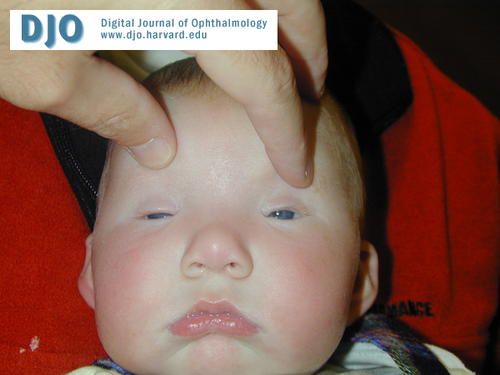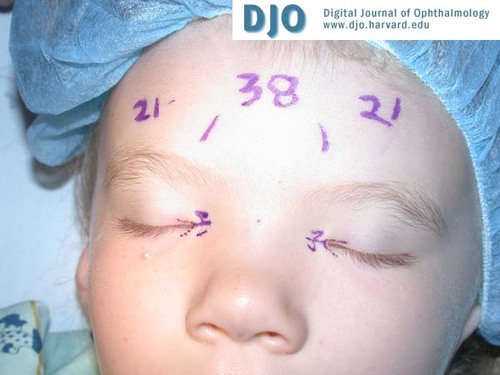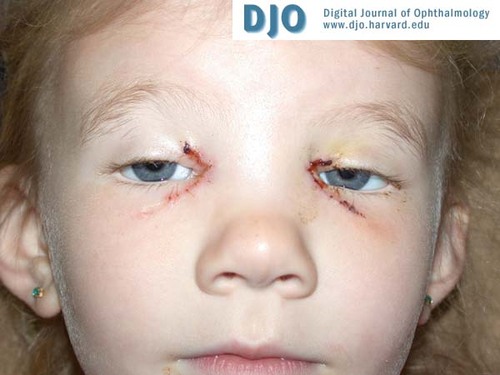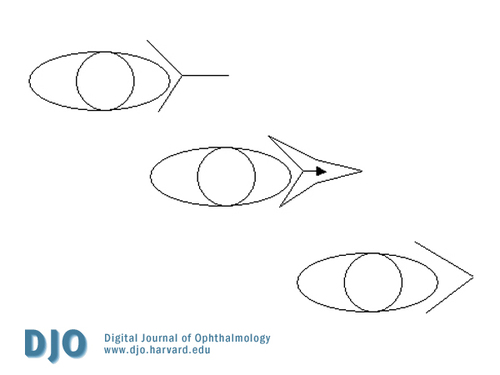Orbit/Oculoplastics Quiz 20: Three-month-old girl with bilateral eyelid abnormalities

Patient at 3 months

5 years

Intraoperative planning

1 week postoperative

"Y" to "V" flap schematic
Answer: Blepharophimosis/ptosis/epicanthus inversus syndrome (BPES).
• Blepharophimosis - horizontal and vertical shortening of the palpebral fissure. The normal palpebral fissure width is 25-30mm. In BPES the palpebral fissure is typically 18-22 mm.
• Ptosis - drooping of the upper eyelid
• Epicanthus inversus – a medial canthal fold of skin is present which is most prominent in the lower lid
2. What are the associated findings in this condition?
Answer: Premature ovarian failure, or secondary amenorrhea, is seen in a subset of patients with BPES (type 1).
According to one study of 204 patients with BPES, 46% had strabismus and 35% had significant refractive errors.
3. Describe the genetics and pathogenesis of the condition?
Answer: BPES is dominantly inherited. It is the only known form of dominantly inherited premature ovarian failure. The gene responsible for BPES has been identified as the FOXL2 gene on chromosome 3q23. It encodes a forkhead transcription factor that is expressed only in the developing fetal eyelid and granulosa cells. There are 2 types of this condition seen. Type I BPES is characterized by the previously mentioned eye findings as well as premature ovarian failure. The mutations responsible for Type I BPES are those that result in a truncated protein. Type II BPES is characterized by the eyelid findings alone. Mutations further downsteam are responsible for type II BPES.
4. What is the differential diagnosis?
Answer: Blepharophimosis can be seen in Fetal alcohol syndrome, Waardenburg syndrome, Marden-Walker syndrome, and a number of mental retardation syndromes such as Ohdo syndrome and Chromosome 3p deletion.
5. What is the treatment?
Answer: Surgical treatment of this condition usually consists medial canthoplasy and ptosis repair. This has been described both in a staged approach and as a single procedure. The canthus is moved medially by shortening the canthal tendon and constructing a “Y” to “V” type reconstruction (see figure).
Sources
Dollfus H, Verloes A. Dysmorphology and the orbital region: a practical clinical approach. Surv Ophthalmol. 2004 Nov-Dec;49(6):547-61.
Cocquet J, De Baere E, Gareil M, Pannetier M, Xia X, Fellous M, Veitia RA. Structure, evolution and expression of the FOXL2 transcription unit. Cytogenet Genome Res. 2003;101(3-4):206-11.
Uhlenhaut NH, Treier M. Foxl2 function in ovarian development. Mol Genet Metab. 2006 Jul;88(3):225-34.
Dawson EL, Hardy TG, Collin JR, Lee JP. The incidence of strabismus and refractive error in patients with blepharophimosis, ptosis and epicanthus inversus syndrome (BPES). Strabismus. 2003 Sep;11(3):173-7.